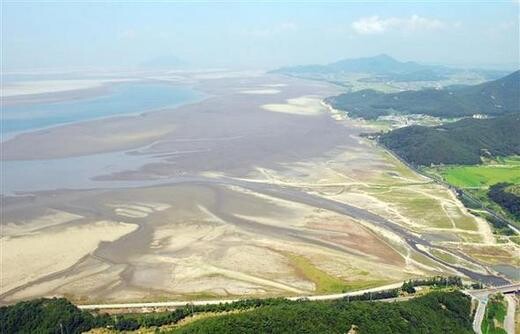hankyoreh
Links to other country sites 다른 나라 사이트 링크
New Saemangeum land development could produce excess pollution and expense

It has been revealed that if the government were to develop the reclaimed lands of Saemangeum as a primarily industrial zone under a new plan announced by the Lee Myung-bak administration earlier this month, it would produce two to three times as much environmental pollution than if it were to be developed as farm land, requiring much greater expenditures for environmental measures.
A report by former Agriculture Minister Chung Woon-chun to current Minister Chang Tae-pyong, released to the press yesterday by Democratic Labor Party lawmaker Kang Ki-gap, says that if the initial Roh administration plan to use 70 percent of the Saemangeum land for agriculture were changed to have 70 percent of the land used for industrial purposes, it would create two to three times the pollution, and the water quality and environmental measures would need to be strengthened. The report also predicted that in order to complete water quality improvement of the Mangyeonggang River and simultaneously develop the Mangyeonggang and Dongjingang river valleys by 2010, costs for environmental measures would need to be increased from 1.4 trillion won to 2.5 trillion won.
On September 5, the government held a hearing at North Jeolla Provincial Hall during which it said it would use 70 percent of the Saemangeum land for industrial purposes to develop it into a Northeast Asian economic center. It also said the schedule of the development of the Mangyeonggang and Dongjingang river valleys, which was initially set to take place consecutively to minimize environmental damage, would be advanced by pursuing them simultaneously. In outlining its plans, the government cited another report jointly produced by five research institutes.
Kang said the data distributed at the hearing simply noted that the project cost would increase from 9.5 trillion won to 19 trillion won; it avoided mention of how much the environment-related budget would increase. Kang also said the creation of the sea walls as part of the land reclamation project had cost 2.3286 trillion won over 17 years, and nobody knew how much the cost of environmental measures would grow in the future. He called for a prudent and transparent approach to the development of Saemangeum.
An Agriculture Ministry official said the data released at the hearing included how much pollution would be produced and environmental measure costs, but a comparison of the government plan with the Roh administration plan was not written in the material. He said this was not an intentional omission; in summarizing the data, the government released the comparative figures by selecting only more important items such as the land use plan and the development method.
Please direct questions or comments to [englishhani@hani.co.kr]
Editorial・opinion
![[Guest essay] Maybe Korea’s rapid population decline is an opportunity, not a crisis [Guest essay] Maybe Korea’s rapid population decline is an opportunity, not a crisis](https://flexible.img.hani.co.kr/flexible/normal/500/300/imgdb/original/2024/0430/9417144634983596.jpg) [Guest essay] Maybe Korea’s rapid population decline is an opportunity, not a crisis
[Guest essay] Maybe Korea’s rapid population decline is an opportunity, not a crisis![[Column] Can Yoon steer diplomacy with Russia, China back on track? [Column] Can Yoon steer diplomacy with Russia, China back on track?](https://flexible.img.hani.co.kr/flexible/normal/500/300/imgdb/original/2024/0430/1617144616798244.jpg) [Column] Can Yoon steer diplomacy with Russia, China back on track?
[Column] Can Yoon steer diplomacy with Russia, China back on track?- [Column] Season 2 of special prosecutor probe may be coming to Korea soon
- [Column] Park Geun-hye déjà vu in Yoon Suk-yeol
- [Editorial] New weight of N. Korea’s nuclear threats makes dialogue all the more urgent
- [Guest essay] The real reason Korea’s new right wants to dub Rhee a founding father
- [Column] ‘Choson’: Is it time we start referring to N. Korea in its own terms?
- [Editorial] Japan’s rewriting of history with Korea has gone too far
- [Column] The president’s questionable capacity for dialogue
- [Column] Are chaebol firms just pizza pies for families to divvy up as they please?
Most viewed articles
- 1Under conservative chief, Korea’s TRC brands teenage wartime massacre victims as traitors
- 2Months and months of overdue wages are pushing migrant workers in Korea into debt
- 3First meeting between Yoon, Lee in 2 years ends without compromise or agreement
- 4[Guest essay] Maybe Korea’s rapid population decline is an opportunity, not a crisis
- 5[Column] Can Yoon steer diplomacy with Russia, China back on track?
- 6‘We must say no’: Seoul defense chief on Korean, USFK involvement in hypothetical Taiwan crisis
- 7After election rout, Yoon’s left with 3 choices for dealing with the opposition
- 8Dermatology, plastic surgery drove record medical tourism to Korea in 2023
- 9[Column] Behind factional animus of Korean politics, victim mentality festers
- 10[Exclusive] Hanshin University deported 22 Uzbeks in manner that felt like abduction, students say